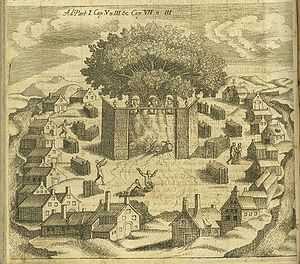Romuva (temple)

Romuva or Romowe (known as Rickoyoto in writings of Simon Grunau)[1] was an alleged pagan worship place (a temple or a sacred area) in western part of Sambia, one of the regions of the pagan Prussia. In contemporary sources the temple was mentioned only once by Peter von Dusburg in 1326. According to his account, Kriwe, the chief priest or "pagan pope", lived at Romuva and ruled over the religion of all the Balts. According to Simon Grunau the temple was central to Prussian mythology. Even though there are considerable doubts whether such a place actually existed, the Lithuanian neo-pagan movement Romuva borrowed its name from the temple.
Historical accounts
According to Peter von Dusburg, the name Romuva is derived from the word Rome. He further describes the Kriwe as a powerful priest who was held in high regard by the Prussians, Lithuanians, and Balts of Livonia. His messengers were recognized from a certain rod or other insignia. He guarded the sacred flame and could look into the destiny of the deceased followers. He received one third of any booty taken by pagan warriors.[2] This early account was further enhanced by Simon Grunau in the 16th century. He described eternal sacred fire, an eternally green oak with idols representing pagan "trinity": Patrimpas (god of spring), Perkūnas (god of thunder) and Patulas (god of the underworld). The place was guarded by priests and vestales.[3] Images appeared based on this description and became very popular with romantic historians. Grunau also changed the name for the place to Rickoyoto (from Prussian rikijs - ruler and -ote - place name derivator)[1] and invented the term Kriwe of Kriwes (Lithuanian: krivių krivaitis, Latvian: krīvu krīvs).[4]
However, no other sources support such statements. The author suggests that pagan cult had hierarchy and internal organization, which is known not to be true. If the Kriwe was such an influential person he must have been mentioned in some political accounts of the region. The supposed location was never found either by the Teutonic Knights, who controlled the entire Nadruvia, or by modern archaeologists.[2] Some details in the descriptions have similarities with other sources. For example, the Treaty of Christburg prohibits converted Prussians from having Tulissones vel Ligaschones at the funerals to see into the journey of the deceased's soul. Another document by the Teutonic Knights speaks of the blûtekirl who collected a third of the booty from Samogitian warriors as an offering to the gods.[2]
Interpretations
Since the concept of a "pagan pope" became very popular during the times of romantic nationalism and very little is actually known about the temple, interpretations abound. S. C. Rowell suggests that Peter von Dusburg invented the place to make the Baltic religion appear like "counter-church". There are many similarities between Romuva and Christian church: in a place called after Rome lived a man treated as pope with his own messengers and insignia.[2] It could have served several purposes: to demonstrate that pagans are so well organized that they have their own pope and pose a serious threat,[1] to shame Christians to respect their own pope or to make pagan society easier to understand to a Christian reader.[2]
Romuva might have been a sacred place, also known as alkas, which were common among Balts. Peter von Dusburg might have exaggerated its importance.[3] There were attempts to link Kriwe with Lizdeika, a semi-legendary pagan priest and advisor to Grand Duke Gediminas. Marceli Kosman, modern Polish historian, called Lizdeika the last Kriwe.[2] Vladimir Toporov argued that the Crooked Castle (castrum curvum) in Vilnius was really Kriwe Castle.[4]
The word may be derived from the Baltic root ram-/rām-, meaning 'calm, serene, quiet', stemming from the Proto-Indo-European *(e)remǝ-.[5] The word Kriwe is derived from kreivas (crooked). It is believed that the term from a crooked stick (also known as Lithuanian: krivulė) that according to Peter von Dusburg was the most important symbol of his power.[4]
See also
References
- ↑ 1.0 1.1 1.2 Bojtár, Endre (1999). Foreword to the Past: A Cultural History of the Baltic People. CEU Press. p. 320. ISBN 963-9116-42-4.
- ↑ 2.0 2.1 2.2 2.3 2.4 2.5 Rowell, S. C. (1994). Lithuania Ascending: A Pagan Empire Within East-Central Europe, 1295-1345. Cambridge Studies in Medieval Life and Thought: Fourth Series. Cambridge University Press. pp. 125–128. ISBN 978-0-521-45011-9.
- ↑ 3.0 3.1 Simas Sužiedėlis, ed. (1970–1978). "Romuva". Encyclopedia Lituanica IV. Boston, Massachusetts: Juozas Kapočius. p. 530. LCC 74-114275.
- ↑ 4.0 4.1 4.2 Bojtár, Endre (1999). Foreword to the Past: A Cultural History of the Baltic People. CEU Press. pp. 337–338. ISBN 963-9116-42-4.
- ↑ Indo-European roots